16 Strategies to Stretch Your Food Budget
If soaring food prices are getting you down, help is on the way! Here are some basic saving strategies, practical solutions, and novel ideas to stretch your food budget—and make your life easier. Granted, one of these strategies on its own is not likely to make a huge difference. But lots of small strategies working together—that’s the way to see huge results.
1. “Grate” Savings
You pay a lot to have someone else grate your cheese for you—at least twice the price of buying cheese by the block. Currently, at my supermarket, cheese in blocks runs from about $2 to $2.50 a pound for the store brand to about $5.00 a pound and more for name brands. The very same cheeses, pre-grated, run almost exactly double across the board, $4 to $10 a pound. Here’s the tip: Grate it yourself. It will stay fresher, and you’ll save money, too.
Why Your Packaged Shredded Cheese Doesn’t Melt Right
Commercially grated or shredded cheese comes with an added ingredient like potato starch or modified cornstarch to prevent “caking” or “clumping.” Well, guess what? Those anti-caking ingredients inhibit melting, too. Now you know why pre-grated or shredded cheese doesn’t seem to always melt as readily, often leaving an odd thickened texture.
2. Keep Breakfast Cheap
Breakfast is one meal that can easily be simple and take up a very small portion of your food budget. Foods like eggs, oatmeal, and toast can all be cheap but also filling ways to start your day.
Bake muffins, quick breads from scratch. Skip the mixes and other superficial time-savers.
Breakfast cereals are pricey! Make sure you buy boxes of cereal ONLY when they are authentically on sale, or you have use-worthy coupons.
3. Breakfast for Dinner
Once a week or so, consider having breakfast for dinner. Kids love this, and so will your food budget. A meal of eggs, pancakes, or waffles and juice is nutritious, meatless, and super cheap (relatively, so).
Get creative with leftovers and watch how far you can stretch your food dollars. Those leftover baked potatoes from last night’s dinner will make fabulous hashbrowns or fried potatoes to go with scrambled eggs.
4. Eat the Sales
Plan your meals around what’s on sale, and you’ll chop your food costs—by up to 50% or more. And when you can load up on super sale items to last until the next time they go on sale. Nearly every grocery store or supermarket publishes a weekly sales ad flyer—and posts it online. What a handy tool to help with meal planning. Eat the sales to stretch your food budget!
5. Double-duty Ingredients
There was a time when if a recipe called for half an onion, I’d toss the other half in the fridge where it would sit until it was over the hill, and I could toss it out guilt-free. What a waste!
The solution is pretty simple: Plan ahead. I know ahead of time that I’m using the other half of that onion for another recipe later in the week, so I wrap it tightly in plastic wrap and store it in the refrigerator.
The same goes for half a pepper, partially used cans of beans, or ground beef. Generally, splitting one portion into two meals is a great way to make your food budget stretch—provided you have at least an idea for how to use the other half!
6. Meal Plan
Not planning meals ahead of time is the best way to blow a lot of money on eating out, picking up, and driving through. It takes time and effort on the front end to plan out meals for a whole week or two, but in the end, saves so much time and money. No more wondering, “What’s for dinner!?
7. Found Food
You know that last slice or two of bread, the hard-as-a-rock end of baguette or crusts you cut off the kid’s sandwiches? Often they’re dry, past prime, and not enough to make anything respectable, so into the garbage they go. Well, not so fast.
Making your own breadcrumbs is as simple as whirring a few slices in a food processor or blender until the bread becomes fine-textured crumbs. Another option is to use that cheese grater!
Bake the crumbs on a baking sheet; 350° F stirring every 10 mins. Depending on how much moisture you’re dealing with and the depth of the crumbs, it should take about 20 to 30 mins.
Make Italian-style seasoned bread crumbs by adding 1 teaspoon dried Italian seasoning blend to every 2 cups to crumbs before baking. Cool completely then store in an airtight container.
8. Veggie Bouquet
Store asparagus in the fridge in a glass of water (like cut flowers in a vase). It will stay fresh for a couple of weeks. Works with celery, too. Discover every possible way you can stop throwing away precious food dollars in the form of rotten produce.
9. Soften Butter in a Flash
Keeping butter out on the counter for an hour isn’t exactly ideal for a tight schedule. Here are three ways to soften butter quickly:
- Drop a still-wrapped stick of butter into a small zip-top bag, seal it shut and place it into a bowl of warm tap water for about 5 minutes or until soft.
- Grate it with a cheese grater and a cold hard stick of butter turns into fluffy soft butter.
- Flatten it with a rolling pin (but put it in a plastic bag first) for spreadable, mixable butter in a pinch.
- Cut that cold stick of butter into small cubes, about 1/2-inch, spread the out and they’ll be soft in about 10 minutes.
10. Longer Lasting Tomatoes
Store tomatoes stem end down to keep them from spoiling as quickly. This prevents air from entering and moisture from exiting the scar where the tomato once attached to the vine. Storing them at room temperature rather than in the fridge also makes tomatoes last longer.
11. Beef in Bulk
Buying the “family size” package of ground beef will chop the cost per pound significantly and really stretch the food budget! But if you use it up faster just because you have more, there go the savings. When you get home you need a reliable way to divide the meat into usable portions.
If a recipe is filling and tastes great with just one pound of ground beef, why use 1 1/4 pounds? If you try to eyeball that amount, you can easily be off by a quarter pound.
Investing in a reliable kitchen scale makes lots of sense. You don’t need anything fancy, just make sure to purchase one that can be easily cleaned. I have this digital multifunction food scale.
Vacuum seal portions before placing them in the refrigerator or freezer. Or wrap portions tightly with plastic wrap, then place them into freezer-type bags that are sealed completely with excess air pushed out.
12. DIY Buttermilk
To make buttermilk when there’s none of the real stuff in the fridge, add a tablespoon of vinegar or lemon juice to a cup of regular or 2% milk. Allow to sit for 10 minutes while it thickens, slightly.
The mixture won’t get as thick and creamy as buttermilk, but it will help create fluffy pancakes and quick bread just the same. Your recipe will turn out great and you’ll have saved yourself an expensive trip to the market. You know the routine—you run in to grab milk and come out with $65 worth of things you didn’t know you needed. Right?
13. Creative Marinade
Tenderize cheaper cuts of meat by marinating them in cola. Several hours ahead of time, place the meat in a bowl and cover with cola (Coke or Dr. Pepper works, too). Add 2 tablespoons soy sauce and 1 teaspoon garlic powder.
While broiling (or grilling), brush the cola marinade over the steaks. This is a great way to use up cola that has gone flat and avoids buying a $6 bottle of prepared marinade.
14. Bye bugs
To protect dry staples such as flour, meal, grits, pasta, and rice from contamination, pop dry bay leaf or two into the container. This won’t affect the taste, but it will prevent pesky bugs from ruining these products.
15. Weigh Bagged Produce
Use the handy scale in the market produce department to weigh pre-weighed bags. For example, if you’re buying a 5-pound bag of potatoes, weigh several bags. The bags will vary and you’re sure to find one that’s 5.5 or heavier, for the same price!
16. Leftover buffet
Take the remains of the week’s meals and serve them for dinner, buffet-style. Need to pad the offerings? Raid the fridge for veggies and dip, make a green salad, or toast some crusty bread. Keep this idea handy. You just might decide to make Leftover Night a regular weekly occurrence!
Question: Got a great tip up your sleeve for how you stretch your food budget? Please share in the comments area below!
Everyday Cheapskate participates in the Amazon Services LLC Associates Program, an affiliate advertising program designed to provide a means for us to earn fees by linking to Amazon affiliated sites.






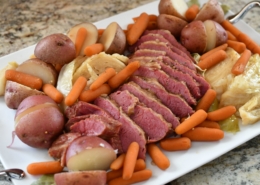

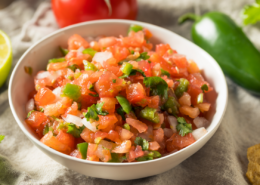
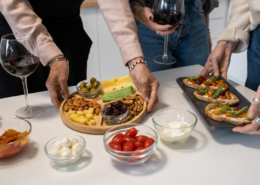

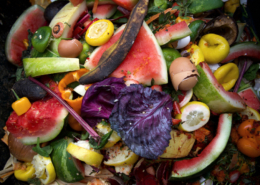
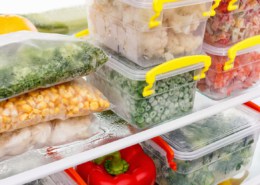



I have found that leaving the stem end on a bell pepper and just cutting of what you need will extend its life. The cut ends will eventually get slimy but they are easy to trim off while the rest of the pepper stays fresh. Also, when my kids were small I would make up my weekly dinner menus with what I already had in the fridge and freezer and then go shopping, only buying what was on sale or discounted at the store. That went into the freezer until I needed it.
Hey Mary, you know those eggs you got on sale at Costco? You can freeze them! Crack them into an old ice cube tray, pop them in the freezer. When frozen , put them into a resealable freezer bag. Take them out, thaw them, and use them in baking and cooking as normal.
If you have part of an onion left, dice it and store it in a bag in the freezer. Another quick resource to speed up dinner next time you need some onion.
I also separate and peel a couple of heads of garlic and store the cloves in a small jar in the freezer. They are good for at least a month, and again save time when you need garlic.
When purchasing any flour or anything made from wheat/almond or any other flour I always place them in the freezer for 3 days (72 hours) or more. Have never had a weevil or any other critter problem since doing this. Save those bay leaves for the other recipes.
WE do NOT wash dishes with a dishwasher, we purchase liquid dish soap. I take the full one and transfer 50% of the liquid to the one that is empty and add warm water to both. Let them sit overnight, and I have two containers of liquid dish soap. My family calls me “Dr. Austéro Severo” LOL
My dad called leftover night – smorgasbord – and it was a regular occurrence in our home of four kids. When my four were still at home, I made menu plans for a month at a time, planning for every leftover. One regular every week was ‘Kitchen sink soup”. I kept a gallon container in the freezer. Every llittle bit of leftover veggies, juice from veggie cans, those last two bites of meat loaf, leftover pasta, etc, were placed in the container during the cleanup from dinner or lunch (and sometimes breakfast – bacon worked great). Then once a week, the container was emptied into my crockpot still frozen, a can of V8 juice and a packet of onion soup mix, and it was left on low all day. By evening we had a hearty soup that never tasted the same each time. Leftover soup was put back in the gallon container and the cycle started up again. I do the same thing still, even though I am only cooking for two, just a smaller container and a smaller crockpot. don’t forget to check the crisper bin for the little bits of produce that can be thrown in too. My grandkids now ask for ‘Kitchen Sink Soup” and my kids all carried on the tradition at their home.
I’ve discovered that buying just the amount of fresh spinach I need for a recipe off the salad bar is fresher and cheaper than buying it in bags from the produce department. I’ve done the same with artichokes and sun dried tomatoes.
I use my food saver alot n I use it so I don’t have to go to the grocery store every week… and I also use my food stamps which saves me alot of money….which isn’t at all embarrassing to use. We are tax payers so j use my taxes to save some money…I use my food saver like when I make meatballs I some times freeze them…I also got my self a small freezer so I can have more things to freeze…
Leftover peppers, onions, meat etc – make stir fry with scrambled eggs and rice.
Tortilla chip crumbs, leftover beans, meat, salsa, grated cheese – make your own version of taco bake casserole.
Brown bananas – freeze and use in smoothies instead of ice cubes.
50% of my household is gluten free so I make “breadcrumbs” out of anything leftover or going stale – tortilla chips, GF crackers, potato chips, cheesy corn puffs – all in the blender, then use them to coat and oven fry fish, chicken, pork
I love all of these ideas! I am very interested in the idea of meal planning. It seems when I don’t know what’s for dinner I stop at the drive thru or pizza place too often. I even have an instant pot but without a plan and ingredients on hand fast food seems to be such an easy way to go. Can you post about meal planning for those of us who would love to get started but need guidance to start? Family can be a bit picky and the home chef meals are good but seem expensive for 2 big eaters and 2 not so big eaters, as there is only one portion of meat, unless you add on, and that gets expensive.
Stretch one leftover portion to two + by adding a prepared pkg. of ramen noodles, if you need less juice only use one cup of water. Works good for pasta dishes, and soups.